
Support Role Guide (Air Defense)
Note: This guide was written using USA team faction in game -- however the gameplay concepts are extremely similar, if not same, for the Russian team as well. While actual units are different, you can apply and play with the same concept shown in this tutorial.
The Basics
We'll quickly show you how to play support when the need arises to clear the sky of those pesky enemy air power.
First thing you want to do is to purchase a Heavy SAM unit in support class.
After you buy your Heavy SAM, you MUST *enable the system* in order for it to work. Simply buying the unit will not do anything. To turn on the system, click ONCE on both Offensive Special Ability and Defensive Special Ability buttons.
The Offensive Special Ability button enables the radar which begins sweeping the sky in 120 degrees boresight from unit's facing, using a phased-array radar that electronically steers its beams.
The Defensive Special Ability button brings your SAM unit into "OPERATE" mode, which enables the main central processing computer that drives your Heavy SAM unit -- this is literally the ON/OFF button for your SAM.
And that's it!
The rest is all automated and your worries are over. The system will automatically engage any air threats it finds. You should now buy Short Range Air Defense System (SHORAD) units, such as the Stinger-equipped Avenger SAM or Vulcan autocannon -- these units are basically same as "Heavy AA" and "Medium AA" units in vanilla WiC. Buy at least 1 SHORAD unit and buy 1 Repair Tank and push them forward to the frontline. The SHORAD unit will provide mobile protection against helicopter threats for your armor player.
As you can see, in MW Mod, AAW is performed in overlapping layers -- the Heavy SAM stays near from your spawn zone providing a massive wide area protective umbrella, while your SHORAD units move to the front-line and maneuver together with your armor player to deal with any enemy helicopter or aircraft that pop up on the move.
Advanced Guide to Anti-Aircraft Warfare (AAW)
in MW Mod - for Expert Players
While playing support in MW Mod 2 has become much easier and beginner-friendly than before, the actual concept of operations (CONOPS) has become much more complex.
WiC is a game that is supposed to be easy to learn, but take life-time to master, as players develop different strategies and tactics to counter each other's moves. The rest of this guide is devoted to expert support players that want to maximize their anti-aircraft warfare (AAW) combat capabilities in WiC. If the details are boring to you, or you simply don't care, you can stop reading right now and get back to the playing game and have fun!
Chapter 1. Understanding Your Threats
In MW Mod 2, air threats have become substantially more diverse, lethal and fast. In order to defeat them properly it is necessary for the support player to fully understand the type of air threats he expects to face.
There are two major threat categories that a Patriot Heavy SAM unit will be facing in the mod: TBMs and ABTs.
Tactical or Theater Ballistic Missiles (TBMs)
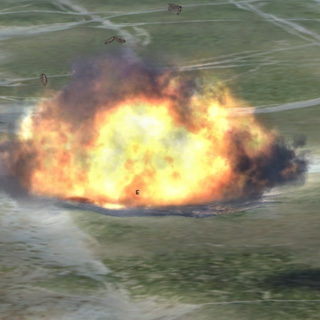 TBMs are surface-to-surface missiles, normally employed in game theater to attack targets of high-value and troop concentration areas, such as command points, armor player sniping area, air defense systems, artilleries and so forth.
TBMs are surface-to-surface missiles, normally employed in game theater to attack targets of high-value and troop concentration areas, such as command points, armor player sniping area, air defense systems, artilleries and so forth.
TBMs represent the most threatening hazard for your team out of all possible air threats that are out there. They carry an extremely lethal warhead, such as 500 to 1,000 lb high-explosive or potentially even nuclear.
TBMs are inherently difficult to defend against. Characteristics that increase TBM effectiveness include reduced radar cross section (RCS), high terminal velocities (extreme speed), difficult to destroy, hardened warhead, and salvo-launch strategy where attacker could launch several TBMs against you. These characteristics affect your detection abilities and engagement timelines, which may result in little to no warning for defending forces. Simply put, TBMs are your worst nightmare.
Air Breathing Threats (ABTs)
Air breathing threats, or "ABT"s are conventional air threats that you are all familiar with. These threats include the following types of specific threats:
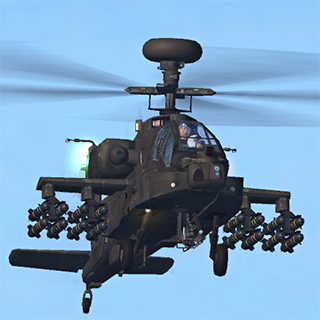
Rotary-Wing Aircraft (Helicopters):
Rotary-wing aircraft, or helicopters, are used to perform a variety of missions including attack, electronic warfare (EW), assault and transport. They can be used to attack troops, armored vehicles, convoys, high-value assets such as artilleries. Weaponry and payloads include guns, rockets, anti-tank guided missiles and electronic countermeasure systems.
Helicopters are difficult for air defense systems to detect, acquire and engage because they are capable of flying at very low altitudes under the hands of a skilled air player, using terrain to mask their presence. Improved fire control and automation capabilities of modern attack helicopters like the Russian Mi-28 and American Apache Longbow enable these rotary-wing aircrafts to search, acquire and fire at ground targets from longer standoff ranges, making them even more deadly. It is true that often times a player that fell victim to an attack helicopter had never even seen the helicopter which had killed him.
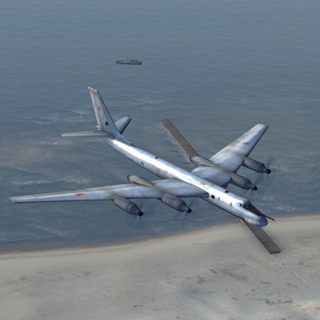
Fixed-Wing Aircraft:
Although enemy fixed-wing aircraft do not present the most challenging threat to air defenses, they remain a formidable threat.
Fixed-wing aviation can be challenging to air defenders in the game, primarily because they can employ air-to-surface missiles and cruise missiles that can outrange the air defender. They are also constantly flying and moving, making them a more difficult target to engage even when discovered. The Russian Tu-142 bomber aircraft can release 6 long-range cruise missiles well outside of the range of your air defenses, making it particularily dangerous to your maneuvering forces.
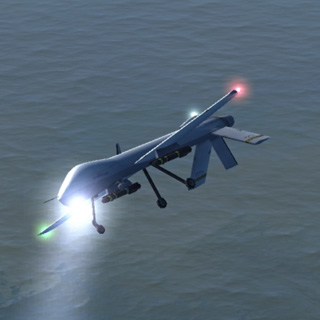
Unmanned Aerial Vehicles (UAVs):
UAVs are unmanned aircraft tasked primarily with reconaissance and battlefield surveillance to attack and electronic warfare. UAVs can spot your teammates and your own units which allows the opposing team to formulate a more lethal attack plan against your forces.
UAVs can be a challenging threat because they are significantly cheaper to employ, consist of relatively low RCS and fly slow. In addition, UAVs can often standoff from enemy fire when conducting reconaissance, so you could be under surveillance by a UAV without you even being aware of it.
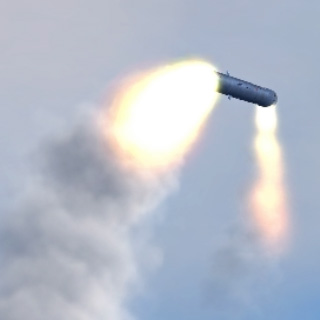
Cruise Missiles (CMs):
CMs are unmanned, self-guided aerial vehicles capable of sustaining flight through aerodynamic lift while carrying a lethal payload. In a game theater environment, they are typically used to target high-value and concentrated troop locations, such as command points, armor player's sniping positions, air defense systems and artilleries.
Defense against CMs is difficult. In flight, they are difficult to detect because they have low RCS and can fly at very low altitudes, often below the radar horizon of your air defense system. They can further evade detection by using natural terrain features such as mountains or valleys to mask their approach, and can attack defended areas from virtually any direction. They can carry a variety of warheads, such as conventional high-explosive, submunitions and possibly even a nuclear warhead.
CMs are often salvo launched by the attacker to increase the likelihood of a successful attack. Combined with reduced detection times, this makes them a lethal threat to you and your team.
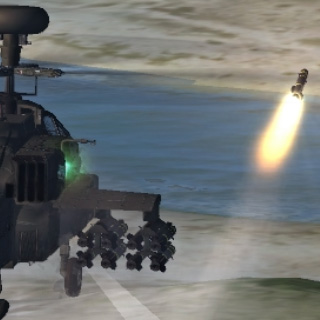
Precision Guided Munitions (PGMs):
PGMs are mostly tactical air-to-surface missiles, such as the Hellfire anti-tank guided missile launched from Apache. PGMs are a lethal threat because of their versatility and pin-point accuracy. Defending from PGM is very difficult because of their high velocities and comparably long standoff ranges. PGMs are extremely lethal against air defense systems, so it is very important for you to disable or kill the carrier (such as attack helicopter) before it could get in range to launch its PGMs against you.
Soft-kill countermeasures, such as smoke screen defensive ability could trash most incoming PGMs.
Chapter 2. Understanding the New Concept of Operations (CONOPS) for Heavy SAM Units
As you can see above, the threats that are facing a support player in game can become very overwhelming for a player to handle. In most games, players typically react to one specific threat at a time. Good players with high Actions Per Minute (APM) capability can multi-task and react to a number of threats simultaneously.
However, in a modern, lethal combat environment offered by MW Mod, the air breathing threats (ABTs) you will face, as well as TBM threats, can come to you from virtually any direction and come at an extremely fast speed. There is absolutely no way that a human player could react to these threats in time to defend himself or his team. A support player could react just in time to destroy one incoming CM to save his teammate, but what do you do when there is 2, or 3 or even 10 incoming? It has become clear that the reaction time, firepower, and operational availability of WiC's Anti-Air units can no longer match the advancing threats of modern air power.
To combat the advancing lethal air power, it is necessary for us to vastly upgrade the AAW capabilities of WiC's support role and use measures to offload lot of tasks off of the support player so that he can concentrate better on playing the game at hand, rather than just trying to survive.
Borrowing the conceptual ideas from the US Navy's Aegis Combat System, we have implemented intense automation and programming software behind the technical engine that drives the new Heavy SAM units in MW Mod 2. The objective of this is to provide a sophisticated Integrated Air Defense System (IADS) simulation for a real-time strategy game, where support player's reaction time has been vastly reduced through extensive automation and computer-aided command and decision process.
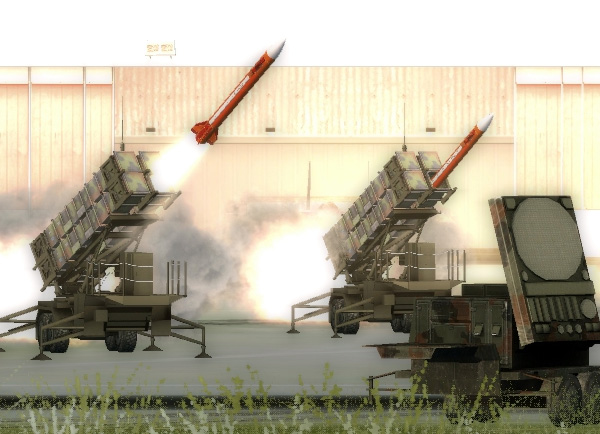
Two Patriot PAC-2 GEM/C missiles race to the sky to intercept incoming air threat. Unlike other anti-air units, these missiles are controlled by Integrated Air Defense System (IADS) network and are individually guided simultaneously against different targets.
Understanding the Integrated Air Defense System (IADS)
Unknown to the player, when you turn on your Heavy SAM unit using the defensive special ability button, behind the scenes, a series of things happen. First, your Heavy SAM unit changes itself to "weapons free" mode, allowing it to engage air targets. Second, it establishes an IADS network where it interconnects and networks with other Heavy SAM units in the battlefield -- even Heavy SAMs that are not owned by you, and owned by another player, is networked with yours. All of this happens without you knowing about it. This is done behind the new programming logic of Heavy SAM units, hidden by the game engine.
By networking every support player's Heavy SAM units to form up a giant web of IADS "network", we bring couple major benefits to your team's AAW capabilities:
First, when facing multiple incoming air threats, your Heavy SAMs do not waste their missiles on the same target. By sharing targeting data and cooperating between units, we can distribute the missile rounds between multiple targets, allowing us to quickly destroy incoming salvo and spam attacks with minimum time required. It is basically a ground-launched "Air-to-Air Strike" tactical aid.
Second, by networking every Heavy SAM together, we increase the firepower and kill-probabilities against high-speed targets such as TBMs and CMs that are traditionally difficult to intercept. The software program determines the Heavy SAM unit that has the highest probability of kill in terms of range and commands it to engage first, while scheduling interception by lower probability units next.
The ability for different Heavy SAM units to share targeting data and execute a coordinated attack program allows your team to effectively defend from multiple incoming air attacks with high efficiency, while requiring minimum to no human input in the process.
Range vs. Effective Range
A common misconception by most people is that a Heavy SAM having the range of 240km will destroy everything flying at 240km. But really?? Let's stop and think about this for a second. If a SAM can destroy everything at such long range, why do countries even bother maintaining an air force with air-superiority fighters? Why is air-superiority such an important concept for Navy's carrier pilots when there are powerful Aegis cruiser escorts? The reason behind that is simple: best defense against aircraft is another aircraft. SAMs from strategic context are only a speed bump and are very good at being point-defense weapons, but definitely NOT good at all in maintaining air supremacy.
Although SAMs are very lethal against aircraft and have extremely high closing speeds, they must also abide by the same rule as aircraft: the aerodynamics. As the rocket is racing itself toward the target, it burns its fuel, this is called powered-flight. During the powered flight, energy is generated for the rocket, allowing it to accelerate and commit to high-G maneuvers, as long as sufficient energy is available.
As fuel runs out, the missile now "coasts", where it continues to fly itself toward the target strictly based on lift generated by inertia -- it no longer has any fuel available to sustain further powered flight and there is no visible smoke trail anymore.
While the missile is coasting, its ability to maneuver with its intended target for a kill diminishes by each passing second. Eventually the missile slows down to a point where its control surfaces become unresponsive and ends up in a gravitational free-fall (or self-destructs), becoming unable to continue its intercept. The aircraft could exploit this by making high-G maneuvers early, forcing the incoming missile to also take high-G maneuvers. When the missile is committed to a high-G maneuver, the energy it had built up during powered flight is depleted much much more quickly. By the time the missile arrives near its target for a kill, a simple maneuver following the initial high-G maneuvers, could dodge the missile simply because it won't have any further energy to maneuver itself to the target.
So then why is the long range SAM any useful you may say? They are still useful against aircraft that doesn't maneuver and quite effective against missiles like CMs because these things don't maneuver either. So the SAM will likely have sufficient energy available to make the intercept at its maximum effective range. You can clearly see here that a SAM in real-life is very good at one thing and that is being a point-defense weapon to deal with anything that leaked past your air force fighter jets.
Air Defense "Footprints" and Short-Range Air Defense Systemse (SHORAD)
This is the diagram showing the engagement ranges of the Patriot Heavy SAM in game:
As you can clearly see, this is one deadly SAM with a huge range that covers pretty much the entire map. But notice the "Aircraft No Escape Zone" circle -- this circle is only roughly half of the SAM's maximum range. This "Aircraft No Escape Zone" is an area where the missile will have sufficient energy available that it can kill even pro air players wihout any problem, even when they are maneuvering and changing course. Outside of this circle, the missiles will lose enough energy that they will not be able to cope with a maneuvering target as effectively. Both rotary-wing and fixed-wing aircraft could actually penetrate your Heavy SAM's range all the way to No Escape Zone circle (that is half of your SAM range), if the air player commits to early maneuvering and flies unpredictably.
So as you can see, the Heavy SAM is lethal, but not THAT lethal as they are advertised to be. The protection "footprint" against maneuvering aircraft, even against helicopters is quite limited at outer range. So it is important that you buy SHORAD unit as well, such as Stinger-equipped Avenger SAM, infantry MANPAD (in case of infantry player) or Vulcan AAA. You should push your SHORAD unit to the frontline to escort your armor player, along with a repair vehicle. This will provide a layered air-defense cover for your team's maneuvering force, where Patriot Heavy SAM forms the wide area protective umbrella, while your SHORAD units deal with the aircraft that has managed to penetrate into Patriot's engagement range. The multi-layered air defense is very important concept for a support player to master.
TBM Footprint vs. ABT Footprint
While SHORAD units are good at killing aircraft that may have violated Heavy SAM's engagement envelope, it is completely useless against TBMs. One of the reasons that makes TBMs so scary is that the only counter to them is Heavy SAM. Moreover, because of TBM's high closing velocity, it is impossible for a Heavy SAM like Patriot to intercept them at their maximum range. Referring to the above diagram, you can see that the "Ballistic Missile Protection Footprint" circle is much smaller than the Heavy SAM's range, in fact, only a fraction of it!
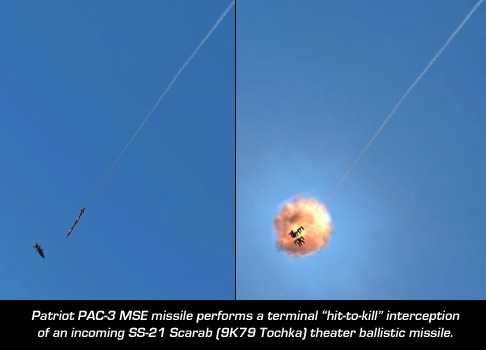
If you and your teammates are outside of this "TBM footprint" circle, expect to get attacked by a TBM. By taking this into account, you may need to forward-deploy your Patriot Heavy SAM a little bit closer toward the frontline, so that its TBM footprint is afforded to your team's maneuvering forces.
But never push a Patriot SAM too close to the frontline. It takes some time for the radar to track an incoming TBM and generate a proper fire solution to intercept it. If you push the Patriot too close to the TBM's launching location, it simply won't have enough time to properly intercept the incoming missile. And remember that TBMs are often used to destroy your Patriot, so it's never a good idea to push it too close to frontline. The best defense against TBMs for front-line troops is to always constantly be on the move and never stay in one spot -- but this is something you should all be aware of by now in WiC, with all those tactical aids being thrown around. For Patriot system itself, the best defense from TBMs is Patriot shooting it down with its own missile.
Chapter 3. How the Patriot Heavy SAM Works in Game
Understanding the behind-the-scenes operational parameters of Patriot SAM will probably help you in gaining better knowledge about how to best use them in a game. It's probably going to bore you with details, but if you've read this far in this tutorial, you're already a nerd anyway.
Operating Principles
The Patriot uses semi-active radar homing (SARH) guidance to direct its missiles onto their targets. The mod team has made several changes in the game to actually kind of "simulate" this mode of guidance.
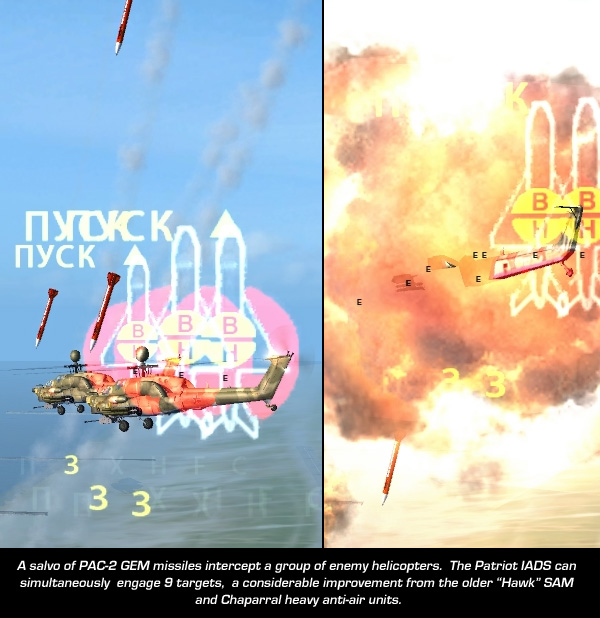
You've probably noticed already that the Patriot missiles in the mod fly like ballistic artillery shells -- they accelerate extremely fast and fly out of the game sky box into very high altitude. Then moments later, suddenly a missile-looking object comes smacking down on its target at very high speed, bringing a new meaning to "death from above". Air players like to call it "fist of god" or "rods from god" or "SAMzilla."
What actually happens is that the Patriot missile that leaves your launcher is actually an invisible air unit of its own -- you just don't see it and you cannot interact with it. This "interceptor unit" is guided by the ground radar software, which generates move orders necessary for this unit to fly to the location to meet its target. This was necessary because it allows us to simulate and track the aerodynamic energy use of the Patriot missile, so the longer it stays up in the air, the less responsive it becomes to continue its intercept against maneuvering target.
Once the Patriot missile interceptor unit arrives near its target, close enough to take a shot, it sends a message back to the program running on the ground radar, telling it "I'm here, ready to attack and here are the targets that I see." The radar then compares the target data from the missile with targets it is currently tracking from ground, and compares them for consistency.
This comparison of data for consistency from two sources -- one from the missile, one from the ground radar, limits the effectiveness of countermeasures, such as electronic jamming (ECM) and also greatly increases accuracy against high speed targets like CMs and TBMs even on multiplayer with moderate to high ping times. This also explains the reason why using EW helicopter to directly jam the Patriot SAM usually ends up being futile. While this is very simplistic in game, the real-life version of this concept is known as "Seeker-Aided Ground Guidance" (SAGG) and "Track-via-Missile" (TVM).
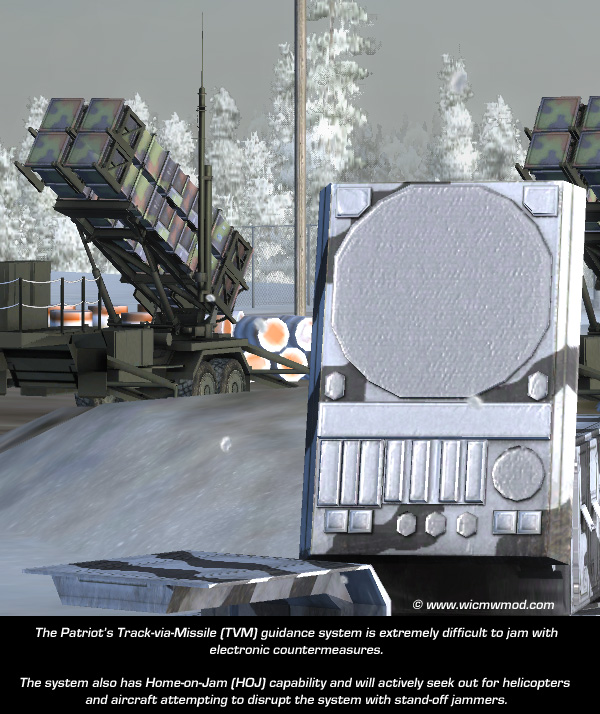
The radar software then selects the target it wants dead and gives green light to the missile unit to attack. In order to achieve this, the radar unit actually "illuminates" the target with an invisible projectile in the game. The illumination immediately triggers missile launch warning icon to be placed on air player's aircraft coming under attack. The missile unit looks out for this modulated illumination signal, then attacks the target that is being painted by it.
Anatomy of Patriot Heavy SAM Unit
The Patriot Heavy SAM unit comes in a squad of several units in game. It contains the following:
- 1x AN/MPQ-65 Search and Track (Multi-Function) Radar
- 6x Transport-Erector Launchers (TELs) with 4x MIM-104E PAC-2 GEM/C Missiles
- 2x TEL with 8x MIM-104F PAC-3 MSE Missiles
(in future versions of the Mod, you'll also see ECS command post, EPP power plant facilities and AMG communications gear in your SAM squad)
So with this setup, you have 24 PAC-2 GEM/C missiles and 16 PAC-3 MSE missiles (total of 40 missiles) to spend attacking your targets. Once you run out of ammo, it will take 120 seconds to reload the TEL.
PAC-2 GEM/C Missile
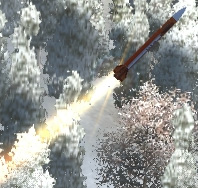 The 24 PAC-2 rounds you have in your Heavy SAM squad are the principal air defense armaments of your team. The PAC-2 rounds are designed primarily to engage ABT threats with additional ability to engage TBMs.
The 24 PAC-2 rounds you have in your Heavy SAM squad are the principal air defense armaments of your team. The PAC-2 rounds are designed primarily to engage ABT threats with additional ability to engage TBMs.
The PAC-2 missiles are long ranged in game and have the range to reach ABT threats for most part of the map. At longer range however, its accuracy will suffer, especially against maneuvering targets.
The big warhead of PAC-2 round makes it especially an ideal weapon of choice against aircraft. Combined with TVM guidance, it is also more difficult to jam with electronic countermeasures. Most of your kills against ABT threats such as helicopters, aircraft and CMs will be performed by the PAC-2 rounds.
PAC-3 MSE Missile
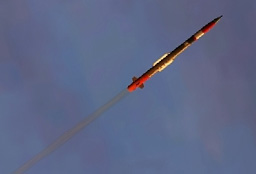 The PAC-3 is effectively your "Medium SAM" unit, that is built right into your Heavy SAM squad. It is a light interceptor rocket that is extremely agile, using side thrusters to achieve a kinetic "hit-to-kill" (HTK) interception.
The PAC-3 is effectively your "Medium SAM" unit, that is built right into your Heavy SAM squad. It is a light interceptor rocket that is extremely agile, using side thrusters to achieve a kinetic "hit-to-kill" (HTK) interception.
The PAC-3's range is substantially smaller than the PAC-2 and is a less capable interceptor against ABT threats such as aircraft and helicopters. However, it is extremely effective at dealing with TBMs and CMs as they are closing in. Even though the PAC-3 has much shorter range than the PAC-2, its TBM footprint is actually larger than that of the PAC-2, because the missile was specifically engineered to address the ballistic ingress and high-closure profile of TBMs and maneuver accordingly as needed.
As air threats are coming close to you, you'll see PAC-3 missile automatically launching as well to add itself to the "basket" to kill as many targets as possible before they come any closer.
Unlike the PAC-2 rounds, the PAC-3 uses an active radar seeker for terminal homing once it is near its target to kill. It will lock onto the target itself with its own radar and collide head-on to achieve an accurate, HTK mid-air collision.
Data Processing Capacity of Patriot SAM IADS
The in-game IADS program written for Patriot Heavy SAM was made with realism considerations in mind, taking conceptual inspirations from the Aegis Combat System as well as from publicly available online information about the Patriot itself.
Even though your Patriot Heavy SAM only comes with total of 28 missiles to spend, which is not enough to deal with a coordinated and concentrated CM/TBM attacks, you also have the power of network-centric warfare afforded to you by the IADS program infrastructure. As you and other support player team up together to deploy more Patriot SAMs, they all automatically (behind the scenes) network together to create one giant, big ammunition cartridge that will allow your entire team to have lot of missiles to spend together.
Since the combination of ammunition resources from different Patriot units allows your team to engage air threats without wasting valuable missile rounds on a same target, the limitation of dealing with saturation CM/TBM attack falls to the data processing capacity of the IADS software.
The Patriot IADS program running behind the scenes in game can process and handle the following:
- Up to 100 targets are tracked. Each target could be an aircraft, CM, TBM, etc.
- For PAC-2 rounds, 9 terminal illumination channels are provided for PAC-2 missiles once they arrive to the target area for end-game kill. This allows 9 targets to be simultaneously attacked in same exact instant, just like an Air-to-Air strike tactical aid.
- For PAC-3 rounds, the engagement capacity is virtually unlimited because of the active radar seeker. But to prevent the PAC-3 missiles from attacking the same target, the software has to provide additional data processing to PAC-3 missile while it is flying. The program will provide this additional data for up to 9 PAC-3 missiles in flight.
This powerful multi-tasking, "multi-channel" engagement software significantly increases the firepower of your team's AAW capabilities against wide array of lethal ABT and TBM threats.
In Open Beta release 1-4, we found that it takes a human player as much as 5-10 seconds to track and score a hit against an incoming CM by manually predicting its movement and commanding his SAM to open fire using offensive ability. You can imagine the pressure when you have 5 or 10 CMs coming at you in high speed.
During development testing, our IADS program had clocked close to 700 APM (Actions Per Minute) when dealing with over 50 incoming CMs, something that human players simply cannot cope with to defend from that kind of heavy saturation attack. However, in a real game, your Heavy SAM will not be able to deal with that many CMs. This test was conducted in a controlled environment where Patriot in game had unlimited radar vision among other "cheating factors", strictly in order to test the maximum possible data processing capacity of the software. Other factors such as radar horizon, terrain, missile ammunition available, target's closing speed and distance all combined will significantly limit the actual number of threats you could simultaneously engage.
Chapter 4: Interpreting Output from Patriot Heavy SAM
As your Patriot Heavy SAM is engaging incoming targets, you'll see several messages scroll through in your team chat screen to provide you with information about the targets you are facing and to keep you up-to-date of what is going on.
The first message you'll see in screen will be something like this:
Someone wrote: Patriot TWS TRACKING 3 AIR, 0 NCT, 1 CM/PGM, 0 TBM
This message tells you the number of air threats that your Patriot system is currently tracking simultaneously, classified by their flight profile.
AIR means aircraft, such as fixed-wing aircraft and rotary-wing/helicopter aircraft.
NCT means "non-cooperative target". When an enemy aircraft is performing a J-cut maneuver or is suddenly stopping in mid-air to try to dodge us, the software identifies the air player as "non-cooperative target" or "NCT." In the event of an NCT classification, the PAC-2 missile is dispatched to the center point (weighted average using vector interpolation) of air player's observed flight pattern, instead of leading his movement.
CM/PGM means cruise missiles and precision-guided munitions.
TBM means tactical ballistic missiles.
As you can see from our above example output, our Patriot SAM is currently engaging 3 aircraft and 1 cruise missile, trying to shoot down all of them simultaneously.
As the Patriot system is engaging its list of targets, the radar continues to scan the sky to find any new targets that may suddenly pop-up as well. When it does, it updates its engagement list with a new message like this below:
Someone wrote: Patriot TWS NEW PICTURE: TRACKING 3 AIR, 0 NCT, 4 CM/PGM, 1 TBM
Now, suddenly we are engaging total of 3 aircraft, 4 cruise missiles and 1 tactical ballistic missile! Let's hope the system can destroy all of them before it's too late.
When Patriot IADS program is commanding your TELs to launch their missiles, you'll see the following message:
Someone wrote: Patriot TCA ENGAGE TRACK 7, LS 102: PAC-2 3 (SAM Launch)
Each air threat we are engaging is assigned with a radar track number. In this instance, we are engaging a target recorded in radar track #7. LS is the unit ID of the Launching Station that is launching the missile, PAC-2 3 means it is launching the 3rd PAC-2 round in that particular unit's TEL.
Note that two PAC-2 missiles are salvo-launched against an incoming target. This makes sure that if we have a miss, the 2nd missile will likely kill the target, increasing our probability of success.
When a PAC-3 is launched against a target track, you'll see that reflected on the message like below:
Someone wrote: Patriot TCA ENGAGE TRACK 9, LS 103: PAC-3/ESSM 7 (SAM Launch)
Additional Event Messages
You'll also see some additional messages that you may want to beware of as well, listed below:
Someone wrote: Patriot TWS TBM (Tactical Ballistic Missile on radar track 3.)
This is a flash alert message notifying you that a TBM has been detected on radar track #3. You may want to consider alerting your teammates over VoIP and look high up in the sky to try to visually track the incoming TBM. Once you can see it with your own eyes, you can predict where it is most likely going to, so your armor/infantry players can determine whether an immediate evacuation may be necessary to dodge the TBM if Patriot fails to intercept it.
Someone wrote: Patriot TWS NCTR (Non-cooperative target on radar track 1. Setting pure-pursuit for mid-course guidance.)
This message is letting you know that the Patriot radar software has detected that a target aircraft has suddenly slowed down in mid-air or is doing some really funny maneuvers. A popular maneuver that the Patriot software is trained to identify is the famous "J-cut" maneuver. The J-cut maneuver is performed by many WiC air players in multiplayer to try to dodge preemptive Air-to-Air Strike tactical aids placed against them. The Patriot software is programmed to identify these maneuvers and classify the air player as an NCT. It then changes the missile guidance logic of PAC-2 round to increase the probability of kill against such a target.
Someone wrote: Patriot ECS TARGET TRACK AIR (ABT contact approaching WEZ, tracking..)
This message is provided when the Patriot has detected an aircraft target, however the aircraft is too far out to PAC-2's maximum range that probability of kill is less than 40%. In this case, the system does not engage the aircraft, but rather continues tracking its movement so that it can be engaged at a later time when it does come closer toward the SAM site.
Someone wrote: Patriot TCA RELOAD (Firing Unit Out of Ammo. Reload in 110 seconds.)
This message is letting you know that a TEL has run out of ammunition. This particular TEL will reload in 110 seconds. This does not mean your entire SAM site is out of the action however, as your other TELs in the squad will continue to engage as long as they have missile rounds available to fire.
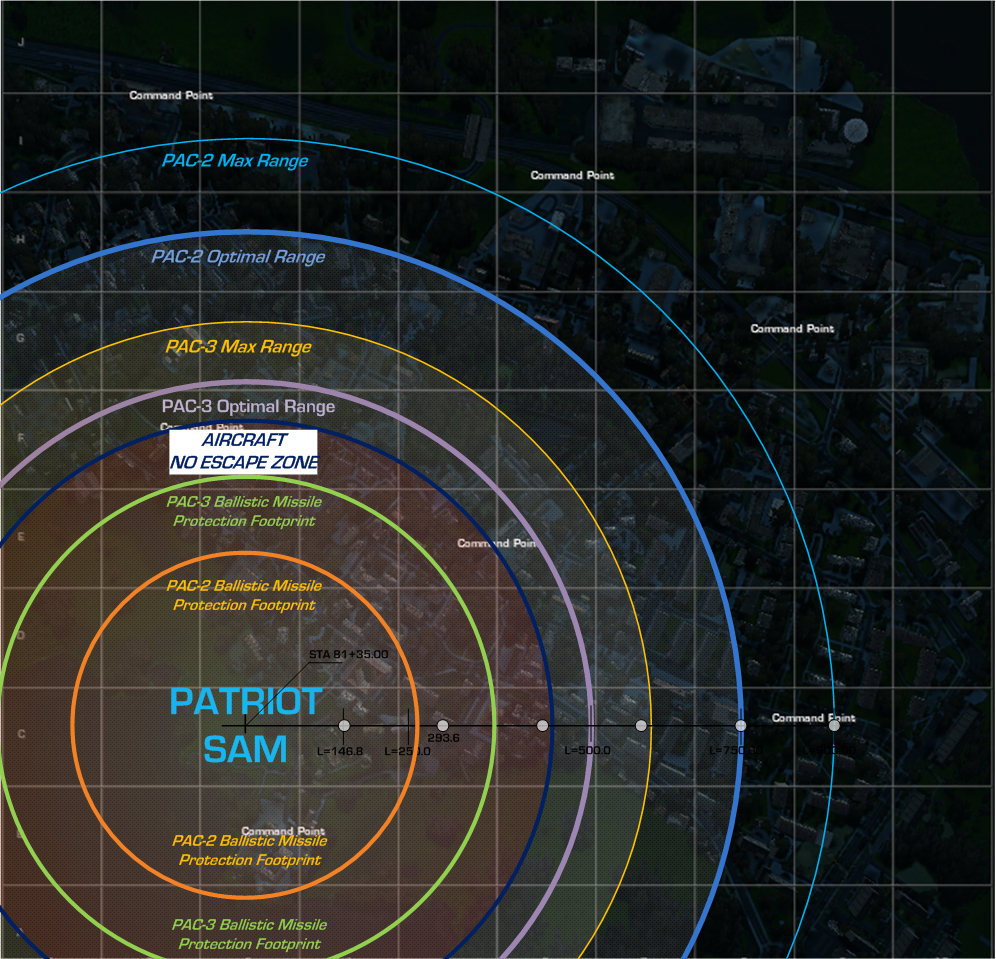



"if the IADS of every side worked half as well as their manufacturers claimed, every aircraft in the world would have been shot down twice" :)
you pointed out that the SAMs now track and attack fixed wing targets; does this mean that they will be able to shoot down tac-aids?
looks good BTW, and I am looking forward to the other tutorials. everyone always seems to forget about infantry and armour
No tactical aids cannot be shot down, because they are animation, not a real aircraft. You cannot shoot down an animated movie because it does not exist in the sky.
But we are introducing a few aircraft-style units, dropped using TA, such as the Tu-142 patrol bomber, Predator drone, etc, where, as long as enemy units are visible by your team, auto-pilot script running in these aircraft units will constantly drive the aircraft to fly in holding pattern.
This comment is currently awaiting admin approval, join now to view.
I remember reading somewhere that shooting down TA's was impossible. I think that the fixed wing targets are the new aircraft they're putting in; UAV's, AC-130, the TU-142, and maybe (hoping) more.
Check the videos.
" It's probably going to bore you with details, but if you've read this far in this tutorial, you're already a nerd anyway." ROFL!
And I have a question, Does it matter the distance between the SAM units in order for them to communicate? I mean if the distance between them is shorter, they "talk" faster and if its very far the message is recieved slower or not at all?
The distance does not matter as much, no (and shouldn't).
This is so complicated but in a good way :)! Its like a whole new game with all these systems and complexity!
Yea, very complex in concept but easy to play for the player (playing support is easier than current open beta).
Air is going to be hard at start I think but once you get 10+ TA to start throwing cruise missiles into right places (i.e. don't attack a SAM site with a single missile b/c it will get shot down, but do attack front-line troops and command points with it), the game goes to hell in a hand-basket for those on the receiving end (hence the need for complex air defense system to keep the cruise missile spam in check, to a manageable level).
This comment is currently awaiting admin approval, join now to view.
Wow, is this just a beta?
I hope to see a full release of this, looks promising.
Can we manage sam's in diffrent directions like another support players that they make thier sam's circle can we do it?